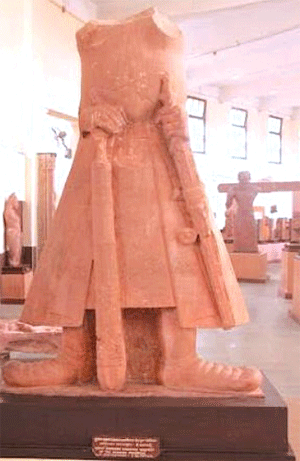
I had been waiting for at least 3 decades for this opportunity. You might consider it strange that anyone could be so keen on seeing a headless statue! The fact was history has always interested me and ever since I had read and seen the photograph of the headless stone image of the Kushan emperor Kanishka, it had remained firmly etched in my mind.
This special sculpture, is said to be the only image of this monarch in existence. And finally an opportunity presented itself when I read about the rich collection of artifacts at the Mathura Museum and discovered purely by chance, that ‘Kanishka’ was housed there! I was returning by road to Delhi from Agra and Mathura was on the way. It was too good a chance to be missed. I coaxed a colleague also travelling with me, to agree to a 2-hour stop to visit the Mathura Museum. She reluctantly agreed, no doubt convinced that I was being eccentric. A visit to the Mathura Temple she could understand, but all this trouble to see some musty old stone sculptures? However my unflagging enthusiasm must have rubbed off on her, for by the time we reached Mathura, just 58 km from Agra, she seemed reconciled to visiting the Museum.
It is quite easy for anyone visiting Agra by road to make a short detour to Mathura - the ancient city located on the banks of the River Yamuna and venerated as the birthplace of Lord Krishna. Regular visitors to Mathura are mostly pilgrims and very few, show any real interest in the priceless treasures housed in the museum. The pity is that very few know about this splendid museum, that has more to offer than most other museums in the country.
We were first directed to the old museum, dating back to 1874, to the time when this museum was founded by the then collector of the Mathura district, Sir F C Growse and named the Curzon Museum of Archaeology. It was a beautiful building and appeared to be ideally suited for housing works of art. However, the museum gradually acquired more and more artefacts over the years including pottery, sculptures, paintings and coins primarily from in and around Mathura, plus discoveries made by colonial archaeologists like Alexander Cunningham, F.S Growse, Fuhrer and others. We were told that despite being specially built as a museum, it had proved much too small for the growing collection of rare artefacts discovered, in the surrounding areas of Mathura.
The government body in charge of the museum, moved the collection to a partially completed circular sandstone building in the 1920s and also changed its name to Archaeology Museum, Mathura. When the building was completed in 1962 the museum was again renamed - the Government Museum, Mathura (also known as Rajkiya Sangrahalaya) is now considered one of the leading museums of Uttar Pradesh and famous for ancient sculptures of the Mathura school dating from the 3rd century BC to the 12th century AC. A repository of the most important collection of the Mathura school of sculpture of the Kushan Empire and the Gupta Empire – it is regional in character, the collection consisting mainly of archaeological finds from Mathura and its adjoining areas. On the occasion of the Museum’s centenary on October 9, 1974, a stamp was issued by the Government of India.
Besides its treasured artifacts, for my friend and me the visit to the Government Museum was made special by the museum’s attentive caretakers. Initially I had thought their enthusiasm was due to the rarity of visitors, but soon discovered that these retainers were genuinely interested in their work. One of them decided to be our guide and appeared to be a real fountain of knowledge. It was he who introduced me with great pride to the museum peon, who had mastered the Brahmi script and was the only one among the staff, who could decipher the texts carved on the stone figures.
At the museum there were many images dating to the reign of the Kushan Dynasty, who captured Bactria and Gandhara from the Greeks in the 1st century AC and ruled Indian territory as far south as the River Narmada. The most famous among these Kushan rulers, Kanishka, reigned until 144th century AC and expanded the Kushan territory even further. Kanishka chose Buddhism as his religion, minted coins during his reign and it was during his regime that the depiction of the Buddha, changed from symbols to human form.
My guide took his task very seriously and introduced Kanishka to me with a flourish – almost as though he was responsible for having created this magnificent image. I have to say the moment was full of drama and my heart almost missed a beat! Kanishka’s headless torso with one hand on a solid royal sceptre and another on the hilt of his sword, was even more impressive than I had expected it to be. As I gazed on this massive figure my guide pointed to the name ‘Kanishko’ written in Brahmi script across the base of the statue.
I was re-living history at the Mathura Museum!





